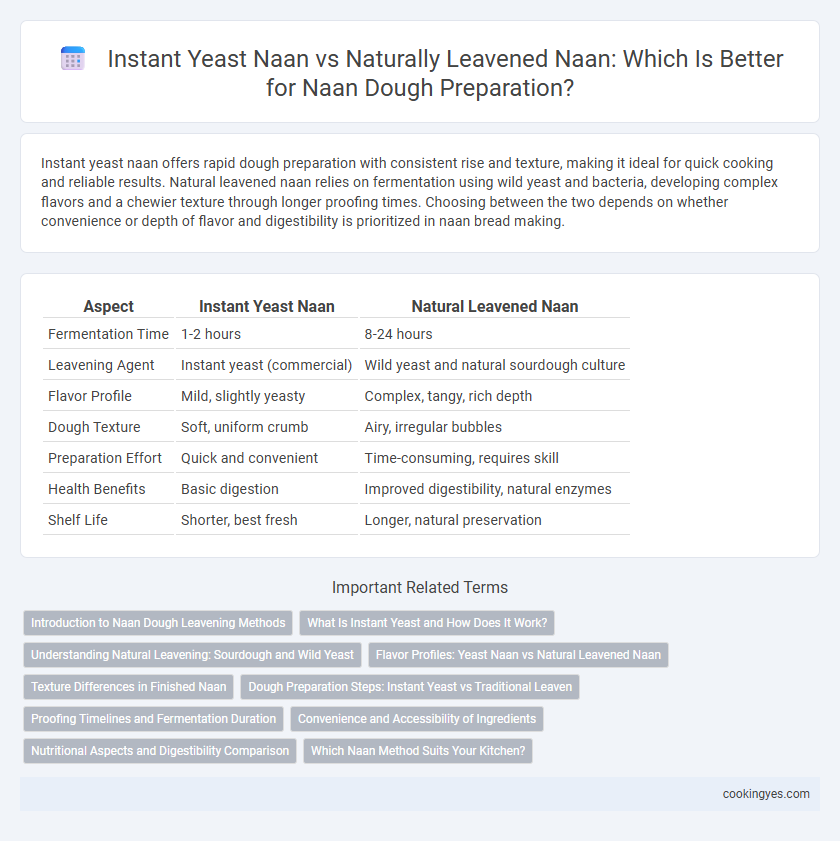Instant yeast naan offers rapid dough preparation with consistent rise and texture, making it ideal for quick cooking and reliable results. Natural leavened naan relies on fermentation using wild yeast and bacteria, developing complex flavors and a chewier texture through longer proofing times. Choosing between the two depends on whether convenience or depth of flavor and digestibility is prioritized in naan bread making.
Table of Comparison
| Aspect | Instant Yeast Naan | Natural Leavened Naan |
|---|---|---|
| Fermentation Time | 1-2 hours | 8-24 hours |
| Leavening Agent | Instant yeast (commercial) | Wild yeast and natural sourdough culture |
| Flavor Profile | Mild, slightly yeasty | Complex, tangy, rich depth |
| Dough Texture | Soft, uniform crumb | Airy, irregular bubbles |
| Preparation Effort | Quick and convenient | Time-consuming, requires skill |
| Health Benefits | Basic digestion | Improved digestibility, natural enzymes |
| Shelf Life | Shorter, best fresh | Longer, natural preservation |
Introduction to Naan Dough Leavening Methods
Instant yeast naan dough offers rapid fermentation, producing soft and fluffy bread within hours, ideal for quick preparation and consistent results. Natural leavened naan relies on wild yeast and lactic acid bacteria, yielding complex flavors and a chewier texture through prolonged fermentation. Understanding these leavening methods helps bakers select between efficiency and traditional flavor profiles in naan production.
What Is Instant Yeast and How Does It Work?
Instant yeast is a dry, active form of yeast known for its fast fermentation, allowing dough to rise quickly without the need for pre-activation. In naan dough preparation, instant yeast accelerates the leavening process, producing a soft and airy texture within a shorter time frame compared to natural leavened naan. This yeast functions by rapidly converting sugars into carbon dioxide and alcohol, creating gas bubbles that cause the dough to expand and develop its characteristic lightness.
Understanding Natural Leavening: Sourdough and Wild Yeast
Natural leavened naan dough relies on wild yeast and lactic acid bacteria naturally present in sourdough starter, which ferments over time to develop complex flavors and improved texture. This fermentation process enhances the dough's elasticity, resulting in a more aerated and chewy naan compared to instant yeast varieties. The microbial diversity in sourdough contributes to a richer nutritional profile and longer shelf life, making natural leavening a preferred choice for artisanal naan preparation.
Flavor Profiles: Yeast Naan vs Natural Leavened Naan
Instant yeast naan dough produces a mildly sweet and uniform flavor with a soft, airy texture due to the rapid fermentation process. Natural leavened naan develops complex, tangy notes and a richer aroma, attributed to the extended fermentation and diverse microflora in the sourdough starter. Flavor intensity and depth in natural leavened naan provide a more artisanal and robust eating experience compared to the straightforward taste of yeast-leavened naan.
Texture Differences in Finished Naan
Instant yeast naan results in a softer, more uniform texture with consistent air pockets, producing a tender and slightly chewy crumb. Natural leavened naan develops a complex, open crumb structure featuring irregular holes and a chewier, more rustic texture due to longer fermentation and organic acid production. The natural fermentation also enhances the naan's flavor profile and creates a distinct crispy exterior compared to the smoother finish of instant yeast-based dough.
Dough Preparation Steps: Instant Yeast vs Traditional Leaven
Instant yeast naan dough involves a quicker preparation process, relying on commercial yeast to rapidly ferment the dough within 1-2 hours, enabling faster rising and immediate baking. Natural leavened naan dough requires a longer fermentation period of 8-12 hours or more, using sourdough or natural starter cultures that develop complex flavors and improve texture over time. The difference in dough preparation steps significantly impacts the naan's taste, crumb structure, and digestibility, with natural leavened dough offering a more artisanal and fermented profile compared to the convenience of instant yeast.
Proofing Timelines and Fermentation Duration
Instant yeast naan dough typically requires a proofing time of 1 to 2 hours, allowing for faster fermentation and quicker preparation. Natural leavened naan, using sourdough or wild yeast, demands longer fermentation periods ranging from 8 to 24 hours, which enhances flavor complexity and texture. Extended fermentation in natural leavening promotes development of organic acids and enzymes, resulting in a more aromatic and digestible bread compared to instant yeast varieties.
Convenience and Accessibility of Ingredients
Instant yeast naan offers significant convenience with quick fermentation times, typically requiring only 1-2 hours for dough rising, making it ideal for fast meal preparation. Natural leavened naan relies on sourdough starters or wild yeast, demanding longer fermentation periods of 12-24 hours, which may not be practical for all home cooks. Ingredients for instant yeast naan are more readily accessible and widely available in most grocery stores, whereas natural leavened naan depends on maintaining a live starter culture, posing challenges in ingredient accessibility and consistency.
Nutritional Aspects and Digestibility Comparison
Instant yeast naan dough tends to have a faster fermentation process, resulting in lower levels of beneficial microbes and enzymes that aid digestion compared to natural leavened naan, which ferments longer and promotes better nutrient absorption. Naturally leavened naan often contains higher amounts of B vitamins and probiotics, enhancing gut health and improving protein and mineral bioavailability. The slower fermentation also breaks down complex carbohydrates, making natural leavened naan easier to digest and less likely to cause bloating or discomfort.
Which Naan Method Suits Your Kitchen?
Instant yeast naan offers rapid dough fermentation, making it ideal for kitchens needing quick preparation and consistent results. Natural leavened naan relies on wild yeast and longer fermentation, producing complex flavors and a chewier texture favored by artisanal bakers. Choosing between instant yeast and natural leaven depends on your kitchen's time constraints, desired flavor profile, and dough handling preferences.
Instant yeast naan vs Natural leavened naan for dough preparation Infographic

 cookingyes.com
cookingyes.com